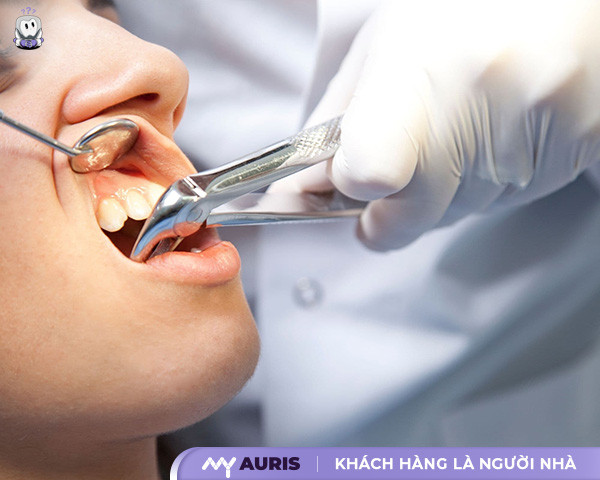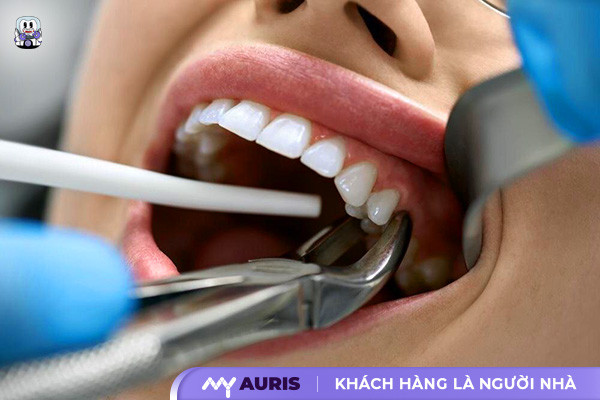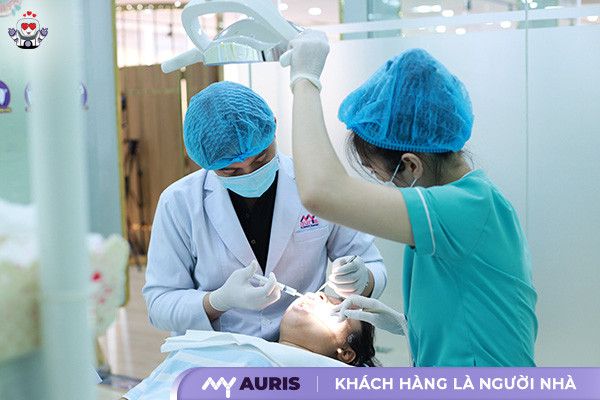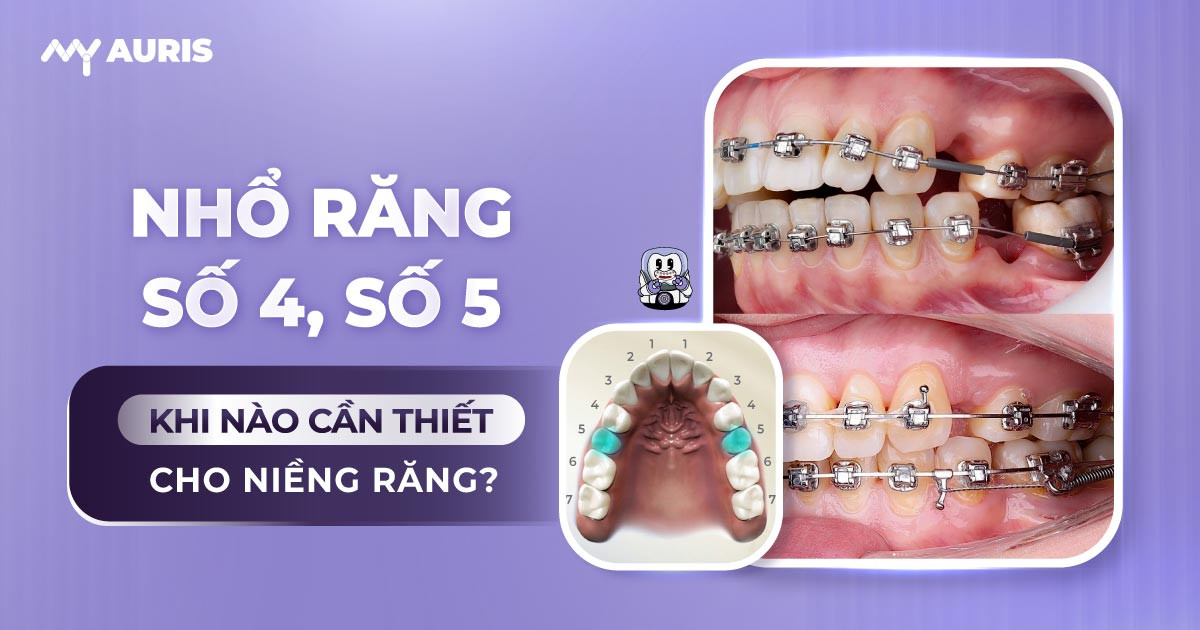The decision to extract teeth #4 and #5 during orthodontic treatment (braces) is a crucial issue that affects oral health, facial aesthetics, and chewing function. Not everyone undergoing braces needs tooth extraction. The necessity of extraction depends on the dental condition, the purpose of the orthodontic treatment, and the orthodontist’s treatment plan. This article by My Auris will provide essential information to help you better understand this matter.
Should Teeth #4 and #5 Be Extracted for Braces?
Some common cases include severe tooth misalignment, crowded teeth, malocclusion, or the need to create space for tooth repositioning. The orthodontist will base the decision to extract teeth on dental X-rays, study models, and clinical examination to assess the oral condition. The necessity of extraction must be carefully considered, weighing its benefits against its impacts. Tooth extraction is only performed when it offers clear benefits for the orthodontic treatment outcome.

In Which Cases is it Necessary to Extract Tooth #4 or #5 for Braces?
During the braces process, creating space for teeth to move is a necessary step. Typically, dentists prioritize extracting tooth #4 because it has less impact on aesthetics and chewing function. However, in some special cases, extracting tooth #5 is necessary to ensure optimal treatment effectiveness.
When is it necessary to extract tooth #5 for braces:
The entire dental arch is protruded, retrognathic, or excessively misaligned, requiring additional space in the posterior region for tooth movement.
Tooth #5 has severe decay, infection, or serious oral diseases, making it impossible to preserve.
In cases where tooth #5 is loose, with a weaker root than tooth #4, affecting the orthodontic process.
Ectopic teeth, growing out of the dental arch, causing an imbalance in the bite.
Tooth #4 is too large or too small, making it unsuitable for extraction in the braces treatment plan.
Regardless of which tooth is extracted, the principle of preserving natural teeth is always paramount. Therefore, dentists will conduct thorough examinations and prescribe the most suitable treatment solution based on the specific oral condition. The decision to extract tooth #5 is only made when no other optimal option is available.
Tooth #4 and Tooth #5: Comparing Differences and Roles in Orthodontics
Before deciding to extract tooth #4 or #5 for orthodontic treatment, it’s important to understand their differences and roles. This helps you grasp the treatment plan and the impact of tooth extraction on oral health, facial aesthetics, and chewing function.
Tooth #4 (first premolar) and tooth #5 (second premolar) are located between the canine (tooth #3) and the molar (tooth #6). They play an important role in the digestive system, assisting molars in grinding food. The position of teeth #4 and #5 affects the bite, facial shape, and smile. Dental X-rays and study models help the orthodontist assess the dental condition, root morphology, and extent of alveolar bone loss.
The difference between tooth #4 and tooth #5 lies in their size, shape, and function. Tooth #5 is generally larger than tooth #4. The root of tooth #5 is also often longer and stronger. Tooth #5 plays a greater role in grinding food than tooth #4. In orthodontics, the decision to extract tooth #4 or tooth #5 depends on the treatment plan, tooth misalignment, and the purpose of the braces. The indication for extraction must be based on a thorough evaluation by the orthodontist, including dental X-rays, study models, and overall oral health.

Braces: Tooth #5 Extraction Procedure
The procedure for extracting tooth #5 for braces is performed according to the following steps:
Examination and Consultation: The orthodontist conducts a general examination of the oral condition, dental arches, and face, takes X-rays, and makes study models to analyze the bite, tooth misalignment, and develop a treatment plan.
Anesthesia: The dentist will administer local anesthesia to the area around tooth #5 to ensure you feel no pain during the extraction process.
Extraction: Using specialized instruments, the dentist will proceed with extracting tooth #5. The dentist will take care to preserve the alveolar bone and avoid damaging adjacent teeth (teeth #4, #6) and soft tissues in the mouth.
Hemostasis: After tooth extraction, the dentist will place gauze at the extraction site to control bleeding.
Post-Extraction Care Instructions: The dentist will provide detailed instructions on how to care for your mouth after extraction, including oral hygiene, diet, and other precautions to avoid complications.
Braces Scheduling: After the wound has healed, the dentist will schedule the placement of brackets and archwires for braces according to the established treatment plan.
Does Extracting Tooth #4 or #5 Have Any Impact?
Extracting teeth #4 and #5 affects many factors: chewing function, facial aesthetics, and oral health. Tooth loss changes the bite and tooth position.
Teeth #4 and #5 play an important role in the digestive system, grinding food. Tooth extraction can reduce chewing efficiency, especially if implants are not placed or teeth are not properly preserved. The orthodontist will assess the dental condition and treatment plan to minimize this impact. They may suggest dental implants or supportive orthodontic appliances after tooth extraction.
Extracting teeth #4 and #5 can sometimes affect facial aesthetics, changing the shape of the mouth and face. However, with braces, the orthodontist will move other teeth to fill the gaps, maintaining aesthetics.

Important Notes After Extracting Tooth #5 for Braces
Immediate Post-Extraction Phase (First 24 hours):
Hemostasis is the priority. Bite firmly on the gauze as instructed by the dentist. Avoid vigorous rinsing, spitting, or touching the extraction site. Limit talking and strenuous activities. Apply ice packs to the outside of your cheek to reduce swelling. Eat soft, liquid, cool foods; avoid hard, hot, spicy foods. Take medication as prescribed by the doctor.
Recovery Phase (1-2 weeks after extraction):
Practice gentle oral hygiene. Brush other teeth normally, avoiding the extraction area for the first few days. Rinse with warm saline solution after each meal. Maintain a soft, liquid diet and supplement nutrition. Avoid smoking, alcohol, and beer. Follow up with your doctor as scheduled. Check the extraction site, archwires, and brackets.
Stabilization Phase (after 2 weeks):
Resume normal oral care. Eat a more varied diet, but still avoid excessively hard foods. Monitor your bite and tooth alignment. Report any unusual signs to the doctor. Continue orthodontic treatment as planned.

Safe Tooth #5 Extraction for Braces at My Auris
My Auris utilizes modern technology, dental X-rays, and study models to assess tooth condition, position, root morphology, bite, and misalignment. Orthodontists at My Auris are highly experienced and specialized, carefully evaluating each case to ensure the tooth #5 extraction procedure is safe and minimizes its impact. We prioritize oral health, tooth nourishment, and comprehensive dental care.
The tooth #5 extraction procedure at My Auris is meticulously performed, strictly adhering to medical standards. Before extraction, the dentist will discuss and clearly explain the treatment plan, the purpose of braces, the necessity of tooth #5 extraction, the procedure, braces cost, and post-extraction oral care. You will be thoroughly advised on various types of braces: brackets, archwires, orthodontic appliances, etc. The extraction process is gentle, minimizing pain. After extraction, the dentist provides detailed instructions on oral care, tooth preservation, and preventing complications during braces treatment.
Your satisfaction is My Auris’s top priority. We are committed to providing a safe, comfortable, and effective orthodontic experience. Here are the reasons why you should choose My Auris:
Experienced orthodontic team: Doctors at My Auris are well-trained and deeply knowledgeable about orthodontics, braces, tooth extraction, dental implants, understanding various types of teeth, and their functions.
Modern technology: My Auris invests in modern equipment, ensuring accurate diagnosis and effective treatment.
International standard procedures: All procedures at My Auris strictly adhere to international standards for medical care, aesthetics, and function.
Dedicated care: We always listen, answer all questions, and support you throughout the treatment process.
Extracting tooth #5, or tooth #4, #3, #6, is part of the orthodontic treatment plan. The goal is to create space for teeth to move, resulting in a beautiful, well-aligned dental arch, a proper bite, improved chewing function, digestive system, facial aesthetics, and overall body. My Auris accompanies you on your journey to perfect your smile. Contact us now for a consultation!





